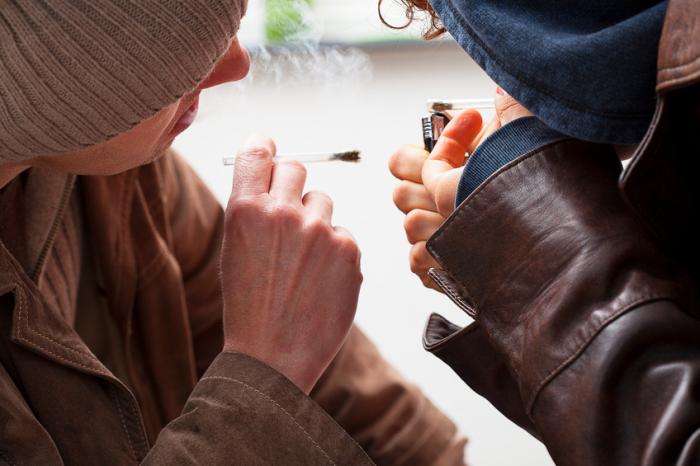'Synthetic marijuana' may cause serious harm to health

Misleadingly marketed as a legal and safe alternative to marijuana, synthetic cannabinoids have a variety of adverse health effects. A new review summarizes the clinical cases that have so far been linked to the use of the synthetic substances.
![[two boys smoking marijuana]](http://cdn1.medicalnewstoday.com/content/images/articles/315/315634/two-boys-smoking-marijuana.jpg)
A new review warns that so-called synthetic marijuana is actually very different from cannabis and is potentially unsafe.
Synthetic cannabinoids (SCBs) are a type of psychotropic chemical increasingly marketed as a safe and legal alternative to marijuana.
They are either sprayed onto dried plants so that they can be smoked, or they are sold as vaporizable and inhalable liquids.
A new review from the University of Arkansas for Medical Sciences (UAMS) warns against the dangerous side effects of the compounds popularly (and misleadingly) referred to as "synthetic marijuana."
Referring to the SCBs currently sold as "K2" and "Spice," Paul L. Prather, a cellular and molecular pharmacologist at UAMS and corresponding author of the review, explains the motivation behind it:
"In the United States, in 2007 or so, we started seeing all kinds of people coming into emergency rooms saying they smoked marijuana, but they had these really bizarre symptoms that did not correspond with the effects you see with marijuana."
The report, therefore, set out to give an overview of the existing literature on SCBs, and to show that not only are they different from marijuana, but also that they do not constitute an appropriate substitute for cannabis. On the contrary, SCBs are drugs in their own right, with many toxic - and sometimes even fatal - effects.
The review has been published in the journal Trends in Pharmacological Sciences.
SCBs are different from marijuana
SBCs are known to create psychotropic effects in much the same way as marijuana - by activating the CB1 cannabinoid receptor, which is found primarily in the brain and the central nervous system. Additionally, in the case of marijuana, its main active ingredient is tetrahydrocannabinol (THC), which also activates the CB2 receptor (found mainly in the immune system).
However, as the authors warn, SCBs activate the CB1 receptor to a much higher intensity than THC does.
William E. Fantegrossi, a behavioral pharmacologist at UAMS and co-author of the review, notes that SCBs "are highly efficacious drugs; they tend to activate the CB1 receptor to a greater degree than we can ever get to with THC from marijuana."
Additionally, the authors caution that because SCBs are chemically different from THC, they may activate other receptors aside from CB1. These cellular receptors, so far unknown, may be causing the negative health effects noticed in SCB users.
SCBs linked to serious adverse health effects and even death
As reported in the review, some of these effects suggest that SCBs cause much more toxicity than marijuana. Toxicity has been reported across a wide range of systems, including the gastrointestinal, neurological, cardiovascular, and renal systems.
The clinical cases documented in the review include acute and long-term symptoms, such as:
- Seizures
- Convulsions
- Catatonia
- Kidney injury
- Hypertension
- Chest pain
- Myocardial toxicity
- Ischemic stroke
Common adverse effects include prolonged and severe vomiting, anxiety, panic attacks, and irritability. Additionally, SCBs reportedly caused extreme psychosis in susceptible individuals, whereas marijuana only causes mild psychosis in those predisposed.
Furthermore, 20 deaths have been linked to SCBs between 2011 and 2014, whereas no deaths were reported among marijuana users during that time.
Finally, SCBs are likely to result in tolerance, dependence, and withdrawal.
SCBs are not safe, authors warn
Because SCBs cannot be detected by standard drug screening, they are particularly popular among users who want to avoid detection, such as teenagers and army personnel. These users often purchase the drugs online, but as Prather and colleagues warn, customers often do not know what they are purchasing because they get something different each time.
"Not only does the amount of the active pharmacological agent change with different batches of drugs, made by different labs, but the active compound itself can change," says Fantegrossi. Prather adds that "there are usually a minimum of three, if not five, different synthetic cannabinoids in a single product."
However, the potential therapeutic benefits of cannabinoids should not be dismissed entirely, write the authors. As with opioids in general, misuse or abuse can have severely adverse or even fatal consequences, but proper use may offer significant benefits.
Overall, though, SCBs should be viewed with suspicion and treated with caution.
"The public sees anything with the marijuana label as potentially safe, but these synthetic compounds are not marijuana [...] You never know what they are, and they are not safe."
Paul L. Prather
420 Intel is Your Source for Marijuana News
420 Intel Canada is your leading news source for the Canadian cannabis industry. Get the latest updates on Canadian cannabis stocks and developments on how Canada continues to be a major player in the worldwide recreational and medical cannabis industry.
420 Intel Canada is the Canadian Industry news outlet that will keep you updated on how these Canadian developments in recreational and medical marijuana will impact the country and the world. Our commitment is to bring you the most important cannabis news stories from across Canada every day of the week.
Marijuana industry news is a constant endeavor with new developments each day. For marijuana news across the True North, 420 Intel Canada promises to bring you quality, Canadian, cannabis industry news.
You can get 420 Intel news delivered directly to your inbox by signing up for our daily marijuana news, ensuring you’re always kept up to date on the ever-changing cannabis industry. To stay even better informed about marijuana legalization news follow us on Twitter, Facebook and LinkedIn.




